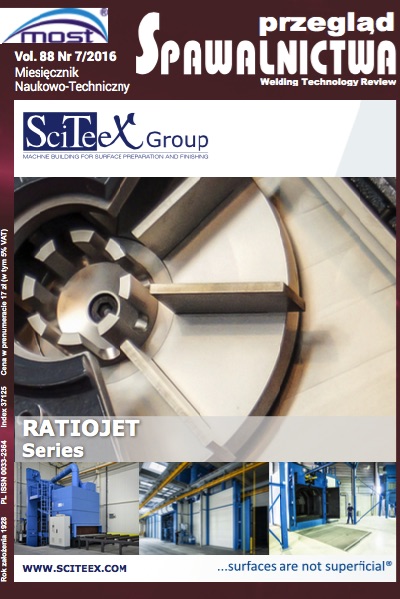Mikrotomograficzna identyfikacja wad powłok napawanych
##plugins.themes.bootstrap3.article.main##
Abstrakt
W artykule przedstawiono wykorzystanie metody tomografii komputerowej CT (ang. Computed Tomography) do oceny powłok napawanych. Do otrzymania napoin wykorzystano metodę napawania elektrodą nietopliwą w osłonie gazowej TIG (ang. tungsten inert gas) z wykorzystaniem stopowych drutów do napawania powłok odpornych na zużycie o nazwach handlowych: EL-500 HB, EL-600 HB, EL-650 HB. Scharakteryzowano typowe wady wykonanych napoin oraz wpływ rodzaju drutu na koncentrację wad. Najmniejszy średni procentowy udział wad w stosunku do powierzchni całkowitej otrzymano dla napoiny EL- 600 HB, który wyniósł 1,5%.
Defects identyfication of padding coatings using X-Ray Mikrotomography method
Abstract
The paper presents the use of Computed Tomography (CT) for the evaluation of padding coatings. The method used to obtain a padding weld is pad welding with tungsten inert gas (TIG) using alloy wires for pad welding of wear resistant layers under the trade names: EL-500 HB, EL-600 HB, EL-650 HB. It characterizes the typical defects of obtained padding welds and the impact of the type of wire on the concentration of defects. The smallest average percentage of defects in relation to the overall surface is observed for the padding weld EL-600 HB, which amounts to 1.5%.
Pobrania
##plugins.themes.bootstrap3.article.details##
Creative Commons CC BY 4.0 https://creativecommons.org/licenses/by/4.0/
Artykuły czasopisma Welding Technology Review (Przegląd Spawalnictwa) publikowane są w otwartym dostępie na licencji CC BY (licencja Creative Commons Uznanie autorstwa 4.0 Międzynarodowe). Licencja CC BY jest najbardziej otwartą dostępną licencją i uważaną za „złoty standard” w formule otwartego dostępu; jest również preferowany przez wielu fundatorów badań. Licencja ta umożliwia czytelnikom kopiowanie i redystrybucję materiału na dowolnym nośniku i w dowolnym formacie, a także zmienianie, przekształcanie lub budowanie na nim materiału, w tym do użytku komercyjnego, pod warunkiem wskazania oryginalnego autora.
Bibliografia
Kolbusz R., Tabor A., Wojciechowski W.: Napawanie elementów spiekanych materiałów konstrukcyjnych, Archives of Foundary, Vol. 6, Nr 21, str. 229-234, 2006.
Pashechko M., Dziedzic K., Barszcz M.: Study of the structure and properties of wear-resistant eutectic Fe-Mn-C-B-Si-Ni-Cr coatings, Powder metallurgy and metal ceramics, nr 7-8, vol. 52, str. 469-476, 2013.
Yüksel N., Sahin S.: Wear behaviorhardnessmicrostructure relation of FeCrC and FeCrCB based hardfacing alloys, Materials and Design Vol. 58, str. 491-498, 2014.
Badisch E., Katsich C., Winkelmann H., Franek F., Manish R.: Wear behavior of hardfaced Fe-Cr-C alloy and austenitic steel under 2-body and 3-body conditions at elevated temperature, Tribology International 43, str. 1234- -1244, 2010.
Ratajczyk E.: Rentgenowska tomografia komputerowa (CT) do zadań przemysłowych, Pomiary Automatyka Robotyka, Vol. 5, str. 104-113, 2012.
Yanga M., Xionga S.-M., Guoa Z.: Characterisation of the 3-D dendrite morphology of magnesium alloys using synchrotron X-ray tomography and 3-D phase-field modelling, Acta Materialia Vol. 92, str. 817, 2015.
Hampel U.: X-ray computed tomography, Industrial Tomography, Systems and Applications, A volume in Woodhead Publishing Series in Electronic and Optical Materials, str. 175-196, 2015.
Kułaszka, A. Chalimoniuk, M. Wieczorowski, M. Brzozowski, D.: The assessment of defects and discontinuities in weldings by means of computed tomography, Przegląd Spawalnictwa, vol. 87, Nr 12, s. 3134, 2015. nictwa 2012, nr 2, str. 24-26.
